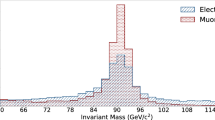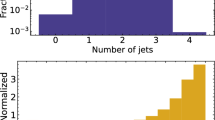Abstract
\(J/\psi \) particle, the ground state of charmonium, is one of the significant probes to understand formation of quark–gluon plasma, a state of deconfined quarks and gluons created in relativistic collisions. \(J/\psi \) is identified by reconstructing the decay products from relevant decay modes with the application of sophisticated techniques mainly based on a high level of physics knowledge and complex computation skills requiring long process time for data quality assurance. For the measurement, a high-purity sample is needed which can be obtained by traditional cut-based methods to extract well-defined particle signal distribution, resulting in high systematic uncertainties. It is revealed that application of artificial intelligence-based machine learning models in various fields enhanced the speed, accuracy, and efficiency of human efforts. Therefore, in this study random forest classifier (RFC), one of the successful classification algorithms, was implemented in measurement of \(J/\psi \) production from its dielectron decay channel. With the RFC model, identification of \(J/\psi \) was studied in three different signal selection approaches: loose track-level analysis, loose pair-level analysis, and tight track-level analysis. The RFC analyses for the charmonium production were found to be compatible with the experimental measurements, and tight signal selection has 98.3% success for predicting the state with 92.9% sensitivity and 93.3% precision. The invariant mass spectrum of \(J/\psi \) was also presented for each approach.




Similar content being viewed by others
References
BRAHMS collaboration, I. Arsene et al., Nucl. Phys. A 757, 1 (2005)
PHOBOS collaboration, B. B. Back et al., Nucl. Phys. A 757, 28 (2005)
STAR collaboration, J. Adams et al., Nucl. Phys. A 757, 102 (2005)
PHENIX collaboration, K. Adcox et al., Nucl. Phys. A 757, 184 (2005)
G. Torrieri, J. Rafelski, Phys. Lett. B 509, 239 (2005)
J. Aichelin, M. Bleicher, Phys. Lett. B 530, 81 (2002)
S.A. Bass, M. Gyulassy, H. Stoecker, W. Greiner, J. Phys. G 25, 1 (1999)
T. Matsui, H. Satz, Phys. Lett. B 178, 416 (1986)
S. Nourbakhsh, Studio degli eventi \(J/\psi \) in due elettroni con i primi dati di CMS (2010)
Particle Data Group, M. Tanabashiet al., Phys. Rev. D 98, 030001 (2018)
NA50 collaboration, B. Alessandro et al., Eur. Phys. J. C 39, 335 (2005)
NA60 collaboration, R. Arnaldi et al., Phys. Rev. Lett. 99, 132302 (2007)
PHENIX collaboration, A. Adare et al., Phys. Rev. Lett. 98, 232301 (2007)
M. D. Schwartz, Modern Machine Learning and Particle Physics. arXiv:2103.12226 (2021)
A. C. Muller, S. Guido, Introduction to Machine Learning with Python (O’Reilly Media, Inc.,), 28-30 (2016)
L. Breiman, Mach. Learn. 45, 5 (2001)
T. Trzcinski, L.K. Graczykowski, M. Glinka, Adv. Intel. Syst. Comput. 945, 3 (2019)
T. Trzcinski, K. Deja, Acta Phys. Polon. Supp. 11, 647 (2018)
T. McCauley, CMS releases open data for Machine Learning, https://cms.cern/news/cms-releases-open-data-machine-learning (2014)
T. McCauley, \(J/\psi \) to two electrons from 2010, https://opendata.cern.ch/record/302, CERN Open Data Portal, https://doi.org/10.7483/OPENDATA.CMS.97YF.C4AH (2014)
T. McCauley, Events with two electrons from 2010, https://opendata.cern.ch/record/304, CERN Open Data Portal, https://doi.org/10.7483/OPENDATA.CMS.PCSW.AHVG (2014)
F. Pedregosa, G. Varoquaux, A. Gramfort, V. Michel, B. Thirion, O. Grisel et al., J. Mach. Learn. Res. 12, 2825 (2011)
P.Z. Skands, Phys. Rev. D 82, 074018 (2010)
NA61/SHINE collaboration, Eur. Phys. J. C 80, 1151 (2020)
CMS collaboration, Phys. Rev. C 96, 014915 (2017)
STAR collaboration, B. I. Abelev et al., Phys. Rev.C 80, 041902 (2009)
ALICE collaboration, B. Chang et al., Phys. Lett. B 776, 91 (2018)
ALICE collaboration, J. High Energ. Phys. 84 (2019)
J.E. Gaiser et al., Phys. Rev. D 34, 711 (1986)
P. Probst, A.-L. Boulesteix, J. Mach. Learn. Res. 18, 1 (2018)
S. Hussain, Z. Raza, G. Giacomini, N. Goswami, Biology 10, 1029 (2021)
Acknowledgements
The author acknowledges the support from the Scientific and Technological Research Council of Turkey (TUBITAK) project no 119F302. Special thanks to Ayben Karasu Uysal and Oguzhan Orhan for their interesting discussions and helpful suggestions.
Author information
Authors and Affiliations
Corresponding author
Rights and permissions
About this article
Cite this article
Kuzu, S.Y. \(J/\psi \) production with machine learning at the LHC. Eur. Phys. J. Plus 137, 392 (2022). https://doi.org/10.1140/epjp/s13360-022-02615-9
Received:
Accepted:
Published:
DOI: https://doi.org/10.1140/epjp/s13360-022-02615-9




